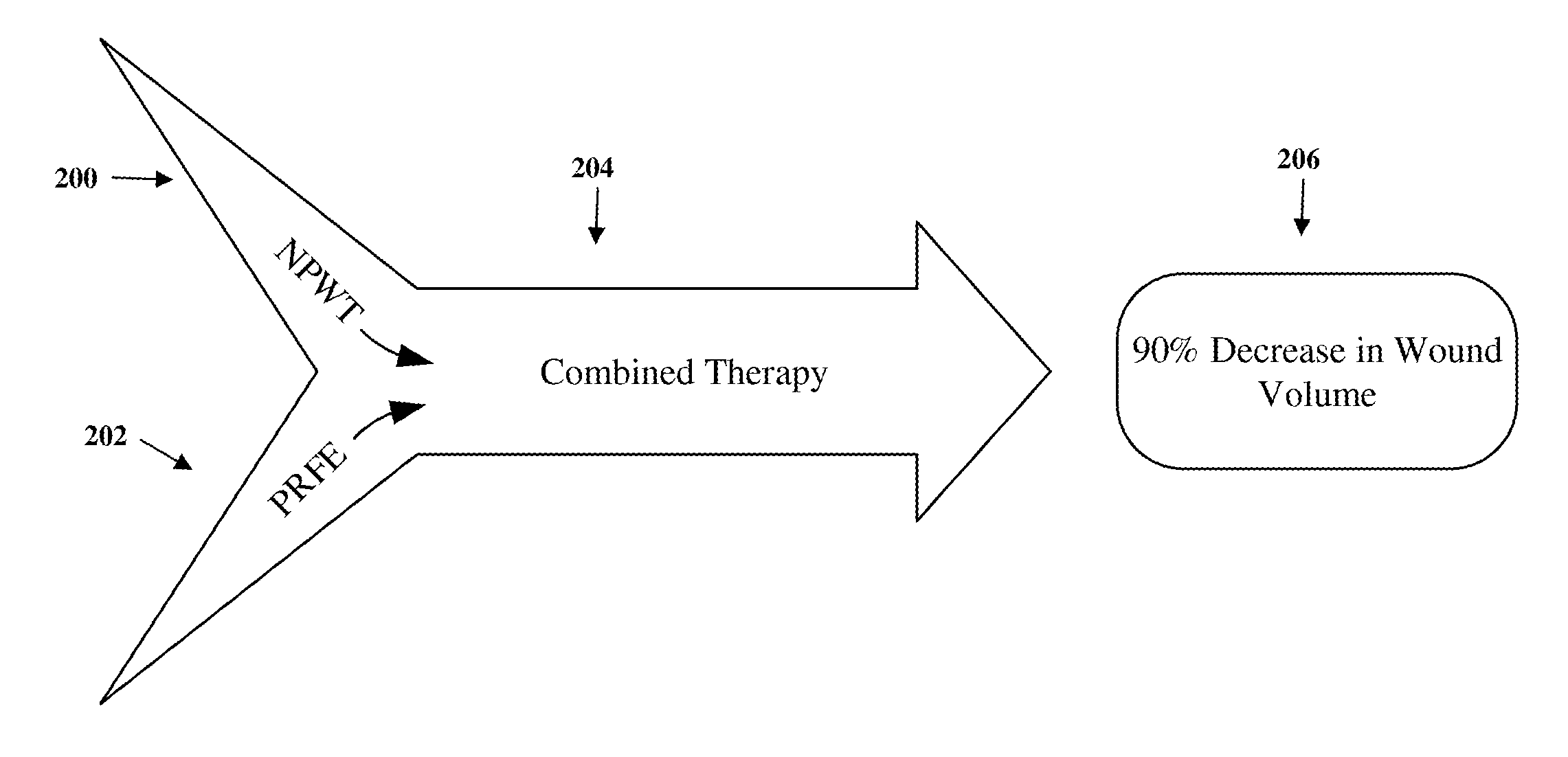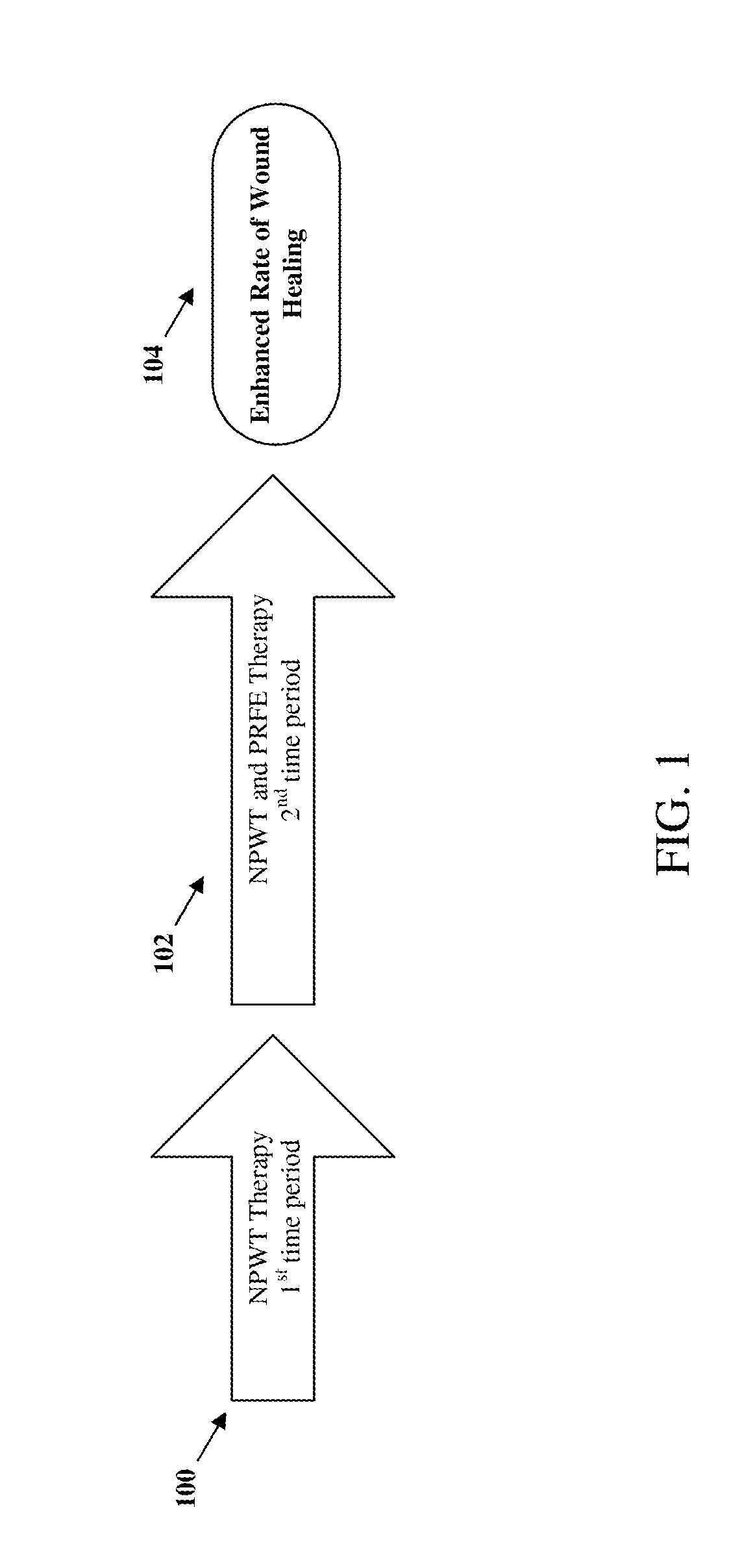Pulsed electromagnetic field and negative pressure therapy wound treatment method and system
a negative pressure therapy and electromagnetic field technology, applied in the field of wound treatment, can solve the problems of unsuitable closure by primary intention, inability to spontaneously heal by secondary intention, and present difficulties to medical personnel, so as to enhance the rate of wound healing, and enhance the effect of wound healing
- Summary
- Abstract
- Description
- Claims
- Application Information
AI Technical Summary
Benefits of technology
Problems solved by technology
Method used
Image
Examples
example 1
Treatment and Closure of an Avulsed Scalp Wound with Significant Bone Exposure Using Pulsed Radio Frequency Energy Treatment and Negative Pressure Treatment
Background
[0086]Wounds involving exposed bone are categorically difficult to manage and slow to heal. Historically, traumatic scalp avulsions have been treated with complex musculo-cutaneous flaps1, skin grafts2, or pure secondary intention3. Successful modern treatment of these wounds demands aggressive, comprehensive combination therapies to expedite granulation, contraction and epithelialization. This example describes the use of a pulsed radio frequency energy treatment (PRFE)4,5 in conjunction with negative pressure wound therapy (NPWT) in the treatment of a serious scalp avulsion.
Case Report
[0087]A 63 year old female presented to the hospital following a roll-over motor vehicle accident. On examination, a full-thickness avulsion injury was identified, with virtually complete detachment of the skin, muscle and fascia on the ...
example 2
Treatment of Pilonidal Wound Using Pulsed Radio Frequency Energy and Negative Pressure Wound Therapy
Introduction
[0093]Pilonidal (herein “PN”) disease occurs commonly among young men (incidence is 1.1% among male college students) and generates considerable morbidity and disability, including chronic sacral wounds, loss of productivity and lifestyle limitation6. Risk factors include Caucasian race, increased sweating associated with sitting and buttock friction, poor personal hygiene, obesity and local trauma. While generally considered an acquired disease, some authorities assert that PN disease is congenital7.
[0094]Among military personnel, PN has historically been a leading cause of nontraumatic sick days. The literature cites a recovery time approximating 100 days8,9. 80,000 US Army soldiers were hospitalized with pilonidal sinus disease for an average of 55 days during World War II10. During one year of the Vietnam conflict, 2,075 US Navy sailors required 90,392 sick days for tr...
example 3
Treatment of Non-Healing Pressure Ulcer in a Patient with Spinal Cord Injury Using Pulsed Radio Frequency Energy and Negative Pressure Wound Therapy
Background
[0113]Pressure ulcers in patients with spinal cord injury may become chronic and resistant to treatment. Complex treatment regimens and adjuvant treatments often are necessary, and results may still be uncertain.
Case Report
[0114]A 60-year-old African-American man presented with a stage IV right proximal coccygeal ulcer that had been present for almost 12 years. The patient had a spinal cord injury at C4 (ASIA A) with spastic quadriplegia that he sustained in a fall in 1996. He had numerous co-morbid conditions. He developed the ulcer shortly after his spinal cord injury, which intermittently improved. He had been in nursing facilities but was eventually discharged to the care of his family. His first primary care visit at our clinic revealed a 1.8 cm×2.1 cm×1.4 cm (volume=5.3 cm3) stage IV pressure ulcer on the right proximal c...
PUM
 Login to View More
Login to View More Abstract
Description
Claims
Application Information
 Login to View More
Login to View More - R&D
- Intellectual Property
- Life Sciences
- Materials
- Tech Scout
- Unparalleled Data Quality
- Higher Quality Content
- 60% Fewer Hallucinations
Browse by: Latest US Patents, China's latest patents, Technical Efficacy Thesaurus, Application Domain, Technology Topic, Popular Technical Reports.
© 2025 PatSnap. All rights reserved.Legal|Privacy policy|Modern Slavery Act Transparency Statement|Sitemap|About US| Contact US: help@patsnap.com



